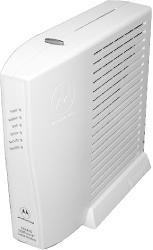Case Study: The Home Network
Figure 5-13 shows the Motorola SB4200 cable modem popularly used to connect to residential broadband services. Many users have ADSL/DSL modems instead of cable; some users even have satellite Internet access. Regardless of whether you use cable, ADSL/DSL, or satellite, you should have a device (such as the cable modem shown in Figure 5-13) with flashing lights and an Ethernet port that provides you with Internet access. You may have bought this device in a computer store or directly from your ISP, or perhaps you rent it from your ISP.

Figure 5-13. The Motorola SB4200 cable modem
Warning
Some ISPs may have supplied you with a device that uses a USB connection to your computer instead of Ethernet, or even a card that was installed inside your computer. To connect your broadband service to a wireless network, you’ll need an external device with an Ethernet port. You may need to contact your ISP’s technical support, explain what you are trying to do (give them the simplest version of the story: you’re trying to connect a wireless access point to your broadband service), and request the correct device. If your ISP refuses to help or doesn’t understand your request, it is time to find a new ISP.
A common limit of broadband connections is that only one computer can be connected to the Internet at any one time. As discussed in Chapter 2, there are many ways the ...
Get Windows XP Unwired now with the O’Reilly learning platform.
O’Reilly members experience books, live events, courses curated by job role, and more from O’Reilly and nearly 200 top publishers.

